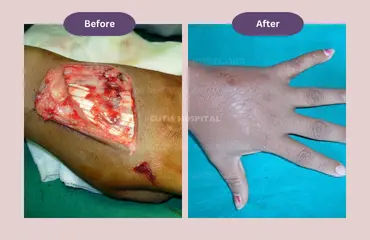Tendons enable body movement, transfer body weight, and protect joints from injury. Any injury to these elastic tissues that join bone to muscles can severely impair their functionality, which makes it difficult for people to perform their daily tasks. Treatment includes Flexor tendon repair surgery that aims to reconstruct or repair the damaged tissues and re-connect them to the bone to regain the functionality.
Tendons are of two types – Flexor and Extensor
Flexor tendons: These function by pulling on the bones. An example, making a fist.
Extensor tendons: These function by stretching a body part outward. An example, standing on toes.
When either of the tendons is damaged, reconstruction can occur into one or two stages.
In one-stage surgery a spare tendon is extracted from the lower leg, foot, or forearm, and sutured to the torn tendon to bridge the defect, and then the newly constructed tendon is re-stitched to the bone.
In a two-stage surgery, a silicone tendon implant is temporarily located in the first operation to create new tendon. After 3 months later, in the second operation, a tendon graft from the body is extracted to replace the silicone tendon.
Between the surgeries regular hand therapy is required to maintain the flexibility of the tissue.
Diagnosis of an injured tendon is made by observing the hand’s resting posture. Flexor tendon reconstruction is done at an out-patient facility under general anesthesia. A short hospital stay is advised after the surgery.
The surgeon makes an incision on the skin over the injured area. The torn tendon is sutured and re-attached to the bone. Further, any damage to surrounding blood vessels and nerves is checked and repaired if needed. When the repair is complete the wound is closed and bandaged.
If however, the injury is severe, artificial tendon or tendon graft may be used for the surgery, and the surgeon may have to conduct multiple surgeries at different time intervals for the repair and healing to complete.
Damaged tendons don’t self-heal, they require medical attention because often the tendon is separated from the bone and needs to be re-stitched. Without Flexor tendon repair surgery, regaining lost movement in hand and wrist is not possible. The surgery is performed under general anaesthetic. The wound is widened to cut the tendon and re-stitched to the bone. The forearm and hand are casted in a plaster splint for immobilization during the recovery phase, which takes 5-6 weeks to heal.
A flexor tendon injury is serious because the wound appears to be small, but the complete functionality of the tendon may be hindered. Complications that can arise due to Flexor tendon reconstruction include:
Repaired tendon breaks again – the tissues are softest at the healing stage and are prone to rupture, easily. Patients may observe that their fingers are not bending. They should immediately consult their surgeon, else the opportunity for tendon repair will be lost in a few days.
Impaired functionality – despite the surgery, the tendon may not slide in its tunnel, which can reduce the movement in the fingers. However, with regular exercise, some mobility can be regained.
Our specialist surgeons are Indian board certified and thus provide superior medical care for patients across all ages and all types of tendon injuries. Our unique multi-disciplinary facility renders access to skilled physical therapists and medical staff who nurse the patients until full recovery is achieved. We believe in dealing with our patients on a personal, affable, and respectful approach.



After the surgery, healing takes 6 to 12 weeks. During this time, the operated area is kept in a cast or splint. Later, braces are used to allow movement. Your doctor will teach you exercises to heal tendon and reduce scar tissue. By following your doctor’s instructions and physical therapy, you’ll be able to heal yourself, quickly.
Flexor tendon repair surgery involves minimal risks – joint pain and stiffness, tendon ruptures again, partial loss of functionality in the injured joint, and scar tissues that hinder smooth mobility.
The surgery leaves behind scar tissues that must be eliminated or reduced for the optimal functioning of your joint. Thus, by performing regular exercises, the movement between the tendon and muscle becomes smoother, and you easily regain the complete functionality of your hand, wrist, or arm.
Within 10-12 weeks you can resume your job, if you strictly follow the flexor tendon repair exercises as directed by your physical therapist. If your job does not require pulling, pushing, lifting, or playing sports, then you can return to your job after 1 week of the surgery, but you need to discuss with your physician, first.
Your doctor and physical therapist work together to reduce stitch disruption. With proper care and exercise, you can easily move your injured hand, wrist, or arm, without stressing the stitches. Moreover, movement will facilitate faster recovery of your joints, and improve the result.
Cutis Hospital is conveniently located in Ghatlodia, Ahmedabad, making it easily accessible via multiple modes of transportation. Below are the various ways you can reach our facility:
Sardar Vallabhbhai Patel International Airport: Located approximately 12.7 km from Cutis Hospital, offering convenient access for patients traveling from outside the city.
Chandlodiya Railway Station: Approximately 2.4 km from Cutis Hospital.
Ahmedabad Railway Station: Around 11 km from our center.
GSRTC:
Ahmedabad Central Bus Station (GSRTC): About 10.3 km from the hospital.
AMTS:
Bhuyangdev Cross Road Bus Stop: Just 500 meters from Cutis Hospital.
BRTS:
Bhuyangdev BRTS Bus Stop: Only 170 meters from our center.
We provide effective surgical and non-surgical treatments for all parts of the body. At Cutis Hospital, our cosmetic and plastic surgery team is committed to giving patients safe and high-quality care.